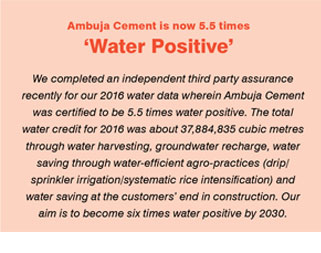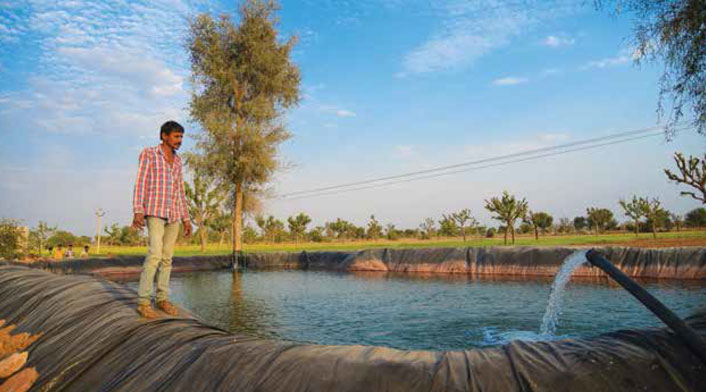Environment. Being future-ready.
Water Management GRI-303, 306
Water conservation has been at the forefront of our sustainability initiatives since our inception. Ambuja Cement is conscious of the importance of the water resources in our operational geographies. Water scarcity affects a large number of stakeholders and is considered as a risk. Our CSR arm, Ambuja Cement Foundation (ACF), has worked extensively in and around the Company’s operational areas to manage water quality in close partnership with the ocal communities, government bodies and NGOs. Their multidimensional approach includes water harvesting; enhancement of water sources; creation of a distribution system for potable water; installation of percolation wells, check dams and roof rain water harvesting structures (RRWHS); and low water-intensive crop farming.
Over four lakh people in the dry, arid territories of Rajasthan, the hilly regions of Darlaghat and the water-scarce state of Andhra Pradesh have benefitted from renovation of traditional water reservoirs, pond deepening, RRWHS and reverse osmosis plants. In the drought-prone region of Kodinar, ACF has worked for over two decades to mitigate the threat of salinity on the livelihood of the people. The objective is to create sustainable access to clean water for drinking and irrigation. More important, ACF engages proactively with the communities to bring about an attitudinal change towards conserving their precious resources. Water User Associations (WUAs) have been established to ensure equitable distribution of water and maintenance of equipment and structures. Farmers are trained in better farming techniques and water management practices such as micro and drip irrigation and systematic rice intensification (SRI) to improve the sustainability of their land. As a result of ACF’s intervention, the farmers of Kodinar and Rabriyawas now reap up to three crops a year.

The total volume of water withdrawn for all our operations in 2016 was about 6.6 million cubic metres (Mm3) as against 6.7 Mm3 in 2015. We reused/recycled about 1 Mm3 of water during the year, which amounted to about 13.5% of our total water withdrawal. The recycled water was treated in sewage or effluent treatment and reverse osmosis plants and used for dust suppression, gardening and other purposes. GRI 303 (1, 3)
Most of our plants do not discharge water or wastewater into natural resources. In 2016, the total water discharged by a few of our plants was 40,689 m3, which is about 0.6% of our total water withdrawal. No water bodies or related habitats were affected by water discharge. GRI 306(1, 5)
Our water resource management efforts that include judicious use of water, setting up of water harvesting structures and recharging water bodies around and beyond our plants has had a positive impact on local water bodies. No public water body has been affected by our operations. The Company’s efforts on water resource management with active participation by the Local Government, other NGOs and the community have been appreciated. Our efforts have actually impacted the biodiversity positively in some areas. No water source or protected area (nationally or internationally) is disturbed for water withdrawal. GRI 303-2
In addition to compliance with regulatory requirements, a water resource estimation study is conducted to assess ground or surface water conservation. Water risk assessment is conducted to understand the possible impact on operations. The Group’s water risk assessment methodology, developed in association with International Union for Conservation of Nature (IUCN), takes business/ Company risks as well as the basin risk into account, covering various risk aspects and identifying units with water stress. This assessment also uses the WBCSD Global Water Tool. The assessment takes into account the impact of eight individual risks: water withdrawal, water discharge, water efficiency, water management practices, basin water scarcity, ecological sensitivity, regulatory and finance, and stakeholder pressure. It also includes a scenario analysis that identifies the potential impact on operations.
More information is available in the ‘Society’ section of this Report.
